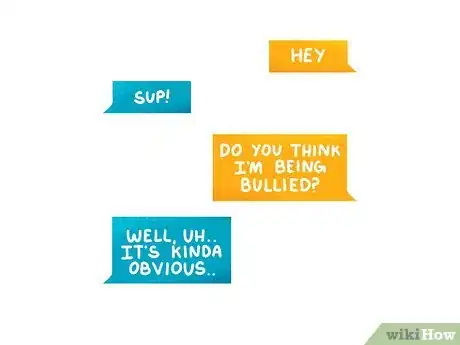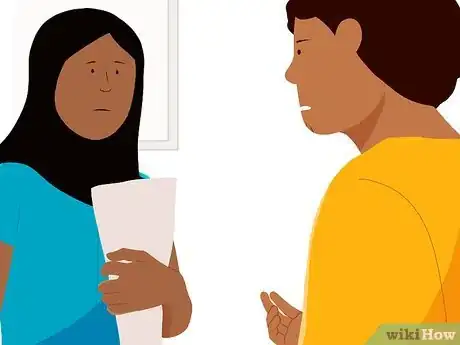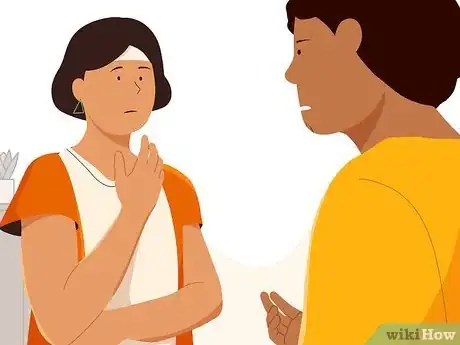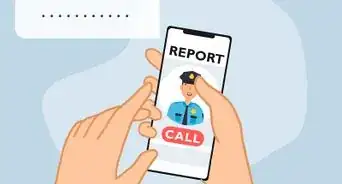This article was co-authored by wikiHow Staff. Our trained team of editors and researchers validate articles for accuracy and comprehensiveness. wikiHow's Content Management Team carefully monitors the work from our editorial staff to ensure that each article is backed by trusted research and meets our high quality standards.
wikiHow marks an article as reader-approved once it receives enough positive feedback. In this case, several readers have written to tell us that this article was helpful to them, earning it our reader-approved status.
This article has been viewed 127,892 times.
Learn more...
Bullying is the most common form of school violence, with approximately 3.2 million students bullied a year, and it is also a common form of workplace violence.[1] It can be difficult to identify bullying behavior and address it, especially when you are the victim. You can identify bullying behavior that is being directed at you by noticing the physical signs of bullying and the verbal signs of bullying. You can then get help with bullying at school or bullying in the workplace by reaching out to authority figures and other support networks.
Steps
Recognizing the Physical Signs
-
1Note if the person punches, hits, or strikes you. One of the most obvious signs of bullying is physical assault in the form of punching, hitting, or striking. The person may physically harm you with his own hands or an object, or he may threaten to physically harm you. Often, a bully will physically assault their victim continuously over a period of time, with each assault becoming more violent and aggressive.[2]
- Many bullies shove or push their victim. If you are being bullied, the bully may inflict minor or major physical injuries on you in places that they know not very many people will see or notice. They may do this to avoid suspicion from a parent or a supervisor.
-
2Notice if the person invades your personal space. Bullies can also inflict physical discomfort in more subtle ways, such as invading your personal space on a continual and relentless basis. If you work in a cubicle or an office, for example, the bully may come in and sit right on your desk or stand in front of your cubicle or office door. If you are trying to work in the library at school, the bully may come and sit right on your school books or pull up a chair very close to you.
- Invading personal space is often done by bullies who are trying to intimidate you or scare you, without using actual physical assault. Bullies may also invade your personal space and then escalate their bullying tactics to physical attacks.
Advertisement -
3Consider ways they can cause pain without hitting you. Making loud noises, pointing bright lights at your eyes, and shoving stinky things in your face can be bullying if the person is doing it with the intent to cause you pain, or ignoring your requests to stop it. They don't have to hit you in order to hurt you.
- Causing sensory pain; this may be tailored to a disability such as flashing lights at a photosensitive person or making loud noise in order to watch an autistic person jump and whimper
- Trying to irritate an injury, such as prodding a broken arm, or dropping things for you to pick up when you have a painful knee injury
- Trying to trigger a medical condition, such as using flash photography to try to trigger a seizure in an epileptic person, or showing graphic content to someone who has PTSD or a phobia
-
4Check if you are physically uncomfortable in the presence of the person. Often, your body will respond to bullying in psychosomatic ways, which is a physical illness that occurs due to mental trauma or stress. This could be an overwhelming feeling of nausea, anxiety, or stress when you are in the presence of the bully, or more physical symptoms like throwing up, a rapid heartbeat, headaches, and panic attacks.[3]
- You may experience physical discomfort in the presence of the bully or during times when you are not around the bully. The night before school, for example, you may feel physically ill at the thought of having to see the bully. Or, you may become nauseated and sick on your drive to work because you know you will need to see the bully in the office. These are all psychosomatic responses to bullying and often will only go away if you deal with the bully.
Recognizing the Verbal Signs
-
1Notice if the person screams, yells, or shouts at you. Verbal attacks in the form of screaming, yelling, or shouting can also be considered bullying. The bully may yell insults at you or mock you loudly in the presence of others. They may also taunt and yell at you when you are alone with them.
- Often, verbal abuse can be as damaging as physical abuse, as you can be mentally and emotionally hurt by the bully’s words. Verbal abuse can often go undetected if it is done quietly and constantly, so it is important to notice if the bully is causing you psychological pain through hurtful words.
-
2Discern the difference between constructive and destructive criticism. Constructive criticism is well-meaning, specific, and designed to help you improve. You come away knowing exactly how to do better. While it can hurt if done too bluntly, it isn't bullying. Destructive criticism contains no useful advice, and is often personally insulting.
- An example of specific and helpful criticism is "This article could use some work. It's a stub at this point, and could benefit from an expansion regarding how to ask the guy out."
- An example of destructive criticism is "This article is useless, unhelpful, and just plain stupid. Clearly the writer has no idea what they are talking about."
- Occasionally, people give ill-meaning advice that appears constructive, but is meant to shut you up instead of help you. This advice may make little sense, and they may flood you with nonsensical critiques intended to frustrate you or erase your agency instead of help you.
-
3Note if the person speaks ill of you to others. Bullies also tend to defame you to others by spreading mean-spirited lies or rumors about you or by making fun of you to others. They may speak ill of you a professional level, such as spreading lies that you continually miss deadlines or that you cheat on every test. They may also speak badly of you on a personal level by attacking your character through lies about your relationships with friends, partners, and family.
- You may hear about the bully’s lies through your friends or coworkers and feel a sense of shame or guilt. Remember that you are not responsible for the bully’s actions and you are not to blame for the bully’s bad behavior.
-
4Consider if they criticize you based on gender or minority status. A bully may draw on existing power dynamics, such as discrimination against Muslims, to attack you. This can make you feel isolated and unsafe, especially when they have the power of general discrimination on their side.
- Minority status can include race, religion, disability (including disability symptoms), LGBTQIA status, gender presentation, size, ethnicity, and more.
- Or, they may try to insult you by comparing you to a stigmatized group, such as saying that you look girly or that you sound like you're disabled, even if you are not a member of that group.
-
5Pay attention to how the person treats you in a group or in front of others. The bully may act in a discriminatory manner to you by singling you out in a group. They may then announce that they are going to treat you differently than everyone else. This is another way for them to exclude you from the group and humiliate you. [4]
-
6Consider how you feel about the situation. Maybe you feel that power dynamics are at play, and you're scared to talk to them, or they can stop you from doing things you care about. Conversations with them may end with you feeling powerless, frustrated, or unable to express how you feel and what you want. You might find your mind wandering back to them again and again, wondering how to deal with them or why they treat you this way.
- Try explaining your feelings using "I" language to the other person. A good person cares about how you feel. For example, if you feel hurt when they joke about your accent, they will stop making those jokes as soon as they find out; they are clueless and not a bully. A bully will tell you that your feelings are unimportant or nonsensical—anything to justify not listening to you.
-
7Recognize when the person seems to set you up to fail. Often, bullies in the workplace tend to try to exercise their power over you in overt ways. One way they may try to exercise power over you is to place an unreasonable amount of workload on you so you are set up to fail. They may also continually pressure you over your missed deadlines or upset clients as a way to make you feel small and helpless.[5]
- The bully may also do this in a school setting, where they get you in trouble with your teacher and causes you to suffer academic setbacks or penalties. They are likely doing this as a way to limit your progress or to prevent you from succeeding.
- This kind of bullying doesn't always involve work. Sometimes bullies will do things to deliberately get you in trouble. For example, if someone tells you to break a rule and then tells your teacher or boss about it, or if they know you're going to get caught doing it, that is bullying.
-
8Ask your coworkers or friends if they believe you are being bullied. Sometimes it can help to get an outside perspective on the situation. Ask your coworkers or close friends if they notice how the person is acting towards you, both physically and verbally. You may want to ensure there is always a coworker or a friend in the room with you when you are near the bully so they can observe the bully’s behavior towards you. They may then be able to deduce if you are in fact being bullied.
Getting Help
-
1Talk to a teacher or a supervisor. If you feel you are being bullied, it is important that you not keep the bullying a secret or hide it from people who can help you. You may be afraid to come forward and report the bully due to fear of backlash from the bully or rejection from your peers. Or you may feel socially isolated from everyone around you and feel no one cares about your well being. But reporting the bully will be the first step to getting the bully to stop hurting you and can help you to recover from the trauma caused by the bullying.[6]
- If there is a teacher at your school you feel close to and trust, reach out to them and talk to them about the bullying. You may want to wait until after class or before class so there is no one else in the room and you can confide in them one on one.
- If there is a supervisor that you feel you have a good relationship with, talk to them about the workplace bullying you have been experiencing at work. Set up a meeting one on one so you have some privacy and can confide in them in a comfortable environment.
-
2Reach out to a counselor or therapist. Your school counselor is trained to address bullying and can often provide professional advice on how to deal with your bully. As well, if you go to a therapist regularly, you may want to talk to them about the bully and discuss ways in which you can address the bullying and make it stop.
- If you are not comfortable with talking to your school counselor, you can also talk to someone via a teen health hotline, found here: http://www.teenhealthandwellness.com/static/hotlines. The hotline is run by individuals trained to help people in need and can often offer a sympathetic ear to discuss your issues.
-
3Confide in a parent, partner, mentor, or someone close to you. Parents are often unaware that their child is being bullied and are only aware of the signs of bullying once their child brings it to their attention. Reach out to a parent or a sibling you feel you can talk to. Together, you can both work to find a solution for the bullying and make sure it stops before it gets any worse.[7]
References
- ↑ https://ista-in.org/know-the-signs-of-bullying
- ↑ http://www.stopbullying.gov/at-risk/warning-signs/index.html
- ↑ https://www.forbes.com/pictures/57324e5b31358e68498f5a8f/work-means-misery/#6c1f9c67876c
- ↑ https://www.forbes.com/pictures/57324e5b31358e68498f5a8f/constant-criticism/#6ce217ef2c0b
- ↑ https://www.forbes.com/pictures/57324e5b31358e68498f5a8f/sabotage/#72a3a9fb38ac
- ↑ http://www.stopbullying.gov/at-risk/warning-signs/index.html
- ↑ https://ista-in.org/know-the-signs-of-bullying
About This Article
It can be hard to tell if you’re being bullied, but there are both verbal and physical signs that can help you figure out what's going on so you can get help if necessary. While punching, hitting, or shoving are all signs of bullying, there are other ways people may bully you without touching you. For instance, a bully may invade your personal space or make loud noises to make you uncomfortable. A bully may also yell at you, mock you, or taunt you. Some bullies may give you backhanded compliments or spread rumors behind your back, which are just subtle ways of tearing you down. If you’re being bullied, don’t be afraid to ask for help. You can tell a teacher, supervisor, parent, or close friend about what’s going on. The bully’s actions are never your fault, and you deserve to feel safe! To learn how to recognize other signs of bullying, read on.













































































